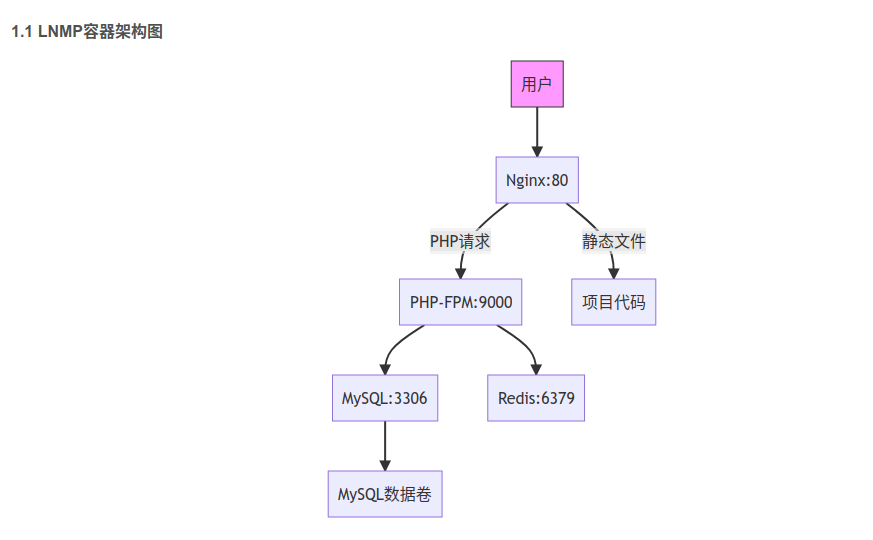一、架构设计与服务规划

二、项目结构准备
lnmp-docker/ ├── docker-compose.yml ├── nginx/ │ ├── conf.d/ │ │ └── app.conf │ └── nginx.conf ├── php/ │ └── Dockerfile ├── mysql/ │ └── my.cnf ├── html/ │ └── index.php └── .env
三、核心配置文件
3.1 docker-compose.yml
ersion: '3.8'
services:
# Web服务
nginx:
image: nginx:1.25-alpine
ports:
- "80:80"
- "443:443"
volumes:
- ./nginx/conf.d:/etc/nginx/conf.d
- ./nginx/nginx.conf:/etc/nginx/nginx.conf
- ./html:/var/www/html
- ./ssl:/etc/nginx/ssl
depends_on:
php:
condition: service_healthy
networks:
- lnmp-net
# PHP处理
php:
build: ./php
volumes:
- ./html:/var/www/html
environment:
- TZ=Asia/Shanghai
healthcheck:
test: ["CMD", "php-fpm", "-t"]
interval: 10s
timeout: 5s
retries: 3
networks:
- lnmp-net
# 数据库
mysql:
image: mysql:8.0-debian
volumes:
- mysql_data:/var/lib/mysql
- ./mysql/my.cnf:/etc/mysql/conf.d/my.cnf
environment:
- MYSQL_ROOT_PASSWORD=${DB_ROOT_PASSWORD}
- MYSQL_DATABASE=${DB_NAME}
- MYSQL_USER=${DB_USER}
- MYSQL_PASSWORD=${DB_PASSWORD}
networks:
- lnmp-net
# 数据库管理
phpmyadmin:
image: phpmyadmin:5.2
ports:
- "8080:80"
environment:
- PMA_HOST=mysql
- PMA_USER=root
- PMA_PASSWORD=${DB_ROOT_PASSWORD}
depends_on:
- mysql
networks:
- lnmp-net
volumes:
mysql_data:
networks:
lnmp-net:
driver: bridge
3.2 PHP Dockerfile
FROM php:8.2-fpm-alpine
# 安装扩展
RUN apk add --no-cache \
freetype-dev \
libjpeg-turbo-dev \
libpng-dev \
libzip-dev \
&& docker-php-ext-configure gd --with-freetype --with-jpeg \
&& docker-php-ext-install -j$(nproc) gd pdo_mysql mysqli zip opcache
# 生产环境优化
RUN { \
echo 'opcache.enable=1'; \
echo 'opcache.memory_consumption=128'; \
echo 'opcache.max_accelerated_files=10000'; \
echo 'opcache.revalidate_freq=60'; \
} > /usr/local/etc/php/conf.d/opcache.ini
WORKDIR /var/www/html
3.3 Nginx配置
# nginx/conf.d/app.conf
server {
listen 80;
server_name localhost;
root /var/www/html;
index index.php index.html;
location / {
try_files $uri $uri/ /index.php?$args;
}
location ~ \.php$ {
fastcgi_pass php:9000;
fastcgi_index index.php;
include fastcgi_params;
fastcgi_param SCRIPT_FILENAME $document_root$fastcgi_script_name;
}
}
四、环境变量配置(.env)
# 数据库配置 DB_ROOT_PASSWORD=SuperSecretRootPass! DB_NAME=app_prod DB_USER=app_user DB_PASSWORD=UserStrongPass123 # 时区配置 TZ=Asia/Shanghai
五、部署与验证
5.1 启动命令
# 构建并启动服务 docker compose up -d --build # 查看服务状态 docker compose ps # 查看实时日志 docker compose logs -f
5.2 环境验证
<?php
// html/index.php
phpinfo();
// 测试数据库连接
try {
$pdo = new PDO(
'mysql:host=mysql;dbname='.getenv('DB_NAME'),
getenv('DB_USER'),
getenv('DB_PASSWORD')
);
echo "Database connection OK!";
} catch (Exception $e) {
echo "Connection failed: " . $e->getMessage();
}
六、生产环境优化建议
1.SSL加密:在nginx配置中添加443端口SSL证书
2.资源限制:在compose文件中添加资源限制
deploy:
resources:
limits:
cpus: '2'
memory: 1G
3.日志切割:配置logrotate管理容器日志
4.备份策略:定时备份MySQL数据卷
docker compose exec mysql sh -c 'exec mysqldump --all-databases -uroot -p"$MYSQL_ROOT_PASSWORD"' > backup.sql
摘自:https://blog.csdn.net/u011570324/article/details/147523961